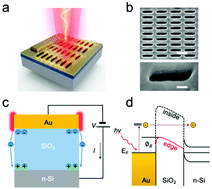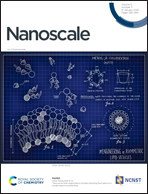Antenna-coupled vacuum channel nano-diode with high quantum efficiency
Abstract
Vacuum channel diodes have the potential to serve as a platform for converting free-space electromagnetic radiation into electronic signals within ultrafast timescales. However, the conversion efficiency is typically very low because conventional vacuum channel diode structures suffer from high surface barriers, especially when using lower energy photon excitation (near-infrared photons or lower). Here, we report on an optical antenna-coupled vacuum channel nano-diode, which demonstrates a greatly improved quantum efficiency up to ∼4% at 800 nm excitation; an efficiency several orders of magnitude higher than any previously reported value. The nano diodes are formed at the cleaved edge of a metal–insulator–semiconductor (MIS) structure, where a gold thin film with nanohole array serves as both the metal electrode and light-harvesting antenna. At the nanoholes-insulator interface, the tunneling barrier is greatly reduced due to the coulombic repulsion induced high local electron density, such that the resonant plasmon induced hot electron population can readily inject into the vacuum channel. The presented vertical tertiary MIS junction enables a new class of high-efficiency, polarization-specific and wavelength- sensitive optical modulated photodetector that has the potential for developing a new generation of opto-electronic systems.

- This article is part of the themed collections: Research selection from the NCNST, Advisory Board research selection and Nanoscale 10th Anniversary Special Issue


 Please wait while we load your content...
Please wait while we load your content...